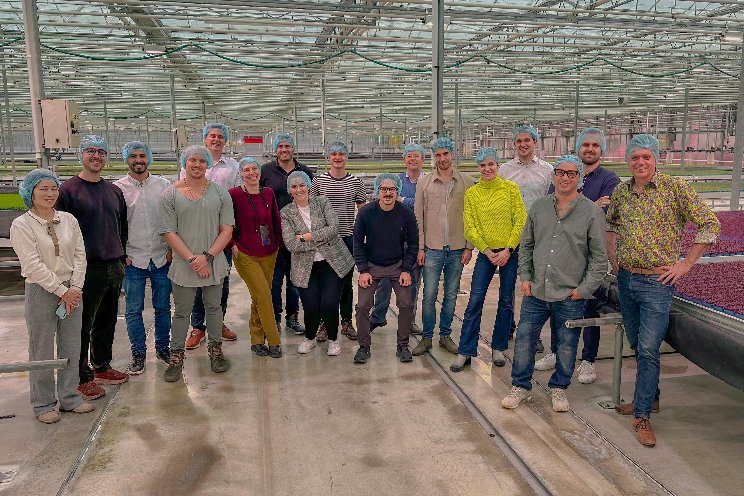Six strategies from the 2023 WIRED Trailblazers
Added on 22 November 2023

For Rautavuori, it was the company’s aim that drew him in: “Tharsus’ purpose is to deliver technology that matters”. Having created innovations that have transformed some of the world’s biggest businesses across myriad sectors, from healthcare to transport, Tharsus seemed to be delivering on their ambition. “After two decades in corporates,” says Rautavuori, “this was the kind of company I aspired to nurture and grow.”
Founded in 1964 by three steel workers who won the football pools, it began life as a welding and fabrication business. Almost 60 years later it has steadily developed into a critical link between product design and volume manufacturing. From advancing “just in time” robotic logistics for Ocado, a global grocery tech giant, to enabling clinical laboratory bench automation for Automata, a tech company that supports life science labs, Tharsus has emerged as a global leader in robotics, industry 4.0, and complex electro-mechanical assembly.
Tharsus’ growth story mirrors a wider trend observed in the UK. Numerous homegrown companies are scaling up thanks to a similar kind of carefully managed, incremental progress that can fly under the radar. In a world where a dominant Silicon Valley narrative lauds the headline-grabbing, meteoric rise of unicorns, organisations that play the long game with clear strategic goals and a well-considered path to sustained profitability are under-celebrated. Yet these businesses are resilient and adaptable in the face of challenging environments and changing conditions, with the ability to sprint rapidly when the moment calls for it. More camels, perhaps, than unicorns. And they are a powerful driving force within the UK economy.
For the second consecutive year, the WIRED Trailblazer Programme, in partnership with HSBC UK, has recognised and celebrated outstanding mid-sized enterprises. This time, 90 enterprises have been meticulously chosen as Trailblazers, showcasing the rich tapestry of businesses across diverse regions of the UK. Some, like Tharsus, boast a storied history dating back decades, while others identified for the programme are newer entrants. But all of them are pioneering products and services that ultimately create benefits for people, communities, and the planet. So, what’s the secret to successfully scaling a Trailblazer business?
We asked some of the leaders at the helm of these companies to share their insights…
1. Watch out for ‘inflection points’
Mark Logan, former Skyscanner Chief Operating Officer (COO) and Chief Entrepreneurial Advisor to the Scottish Government, observes a familiar pattern when scaling a business. In the early stages, growth is relatively smooth. More people means proportionally greater outcomes, and established ways of working are able to scale accordingly. But beyond 30 to 50 employees, organisations start to experience what Logan calls “inflection points”. These are junctures at which the operating structures and processes that previously worked so well are no longer fit for purpose. Decision making stalls, productivity slows, and people become frustrated.
These inflection points are not one-offs, and in Logan’s view, you can expect them again as your workforce hits new milestones of around 100, 200, 400, and 1,000 heads. Alongside using headcount to predict inflection points, Logan also recommends taking regular “temperature checks” of top talent within the organisation—engaging with people to understand their feelings and frustrations.
Getting through these inflection points is critical to growth, and it requires the adoption of new operational structures and processes that optimise for the needs of the larger organisation. When working out how to optimise, it’s important to recognise that not all the solutions might not come from within. Logan advocates looking outwards, identifying best practice from others, and adapting tried and tested approaches.
One company currently refining its operational processes is Cambridge GaN Devices, a WIRED Trailblazer and Cambridge University spin-out developing and commercialising semiconductors based on innovative gallium nitride transistors and integrated circuit technologies. Co-founded by Dr. Giorgia Longobardi and Prof. Florin Udrea in 2016, the company now operates across five locations across the world, including Taiwan, Europe, and the US. For Longobardi, revisiting decision-making processes, and devolving more of them, has been an essential enabler of growth. Having appointed departmental heads across domains from marketing to HR, her latest move was to recruit a COO. “Now that we are experiencing a growth phase, a COO will play a pivotal role in our next stage, alongside our VP of Finance, who will support us in scaling and expanding our global footprint,” she says. “Our current focus is on crafting a well-oiled operational machine.’’
2. Identify and nurture your future leaders
When planning the leadership team of the future, leaders can often fall into the trap of underestimating the potential of their existing talent pool. As Logan points out: “A substantial portion of your future leaders are already in your organisation—your job is to work out who they are.” This approach not only offers attractive career paths for current employees but reduces the cost of hiring for senior positions externally.
David Craig, CEO of Sheffield-based Iceotope, a provider of innovative liquid-cooling systems for servers, recognises the benefits of growing talent from within. He considers it an essential element of Iceotope’s growth. According to Craig, identifying that talent requires a mix of strategic assessment and intuition. “Look across your workforce and ask, who exhibits curiosity by asking questions? Who engages in thoughtful problem-solving? Who can be trusted to get stuff done? Who has that unmistakable spark in their eyes?”
Once you’ve pinpointed these employees, Craig says there is a next crucial step: granting them agency and autonomy. This entails establishing well-defined roles, delegating decision-making, providing the necessary resources to fulfil their responsibilities, acknowledging their initiative, and periodically adapting the levels of autonomy based on their performance. As employees gain the freedom to make decisions and take measured risks, they become more engaged, and your organisation becomes increasingly adept at tackling challenges. On the flip side, neglecting to empower employees may lead to poor initiative, disengagement, and high staff turnover rates.
3. Consider diverse sources of funding
Scaling companies have to contend with evolving circumstances both internally and externally. For leaders of these scale-ups, significant opportunities and challenges can emerge at pace, requiring agile thinking and rapid decision making. At these times, pivots are made, new directions are taken and products and services evolve. The route that a company has taken in funding its growth and expansion can have a significant impact on what decisions are made and by who. Some funders will give leaders autonomy in decision making and others will expect to have their say. Choosing the right funders, with the right priorities, demands careful consideration rather than rushed commitment.
In 2016, Marie Burrows and Jamie Burrows co-founded Vertical Future, a globally-recognised vertical farming technology and data company on a mission to improve both planetary and population health. After two years of primarily self-funding the business, they became profitable. However, with business expansion came increased operational costs, requiring a critical injection of capital. Yet, despite venture capital (VC) interest, they opted to secure their upfront investments from family and high-net-worth individuals who shared their ambitions. This provided both financial fuel and the autonomy to realise their vision of developing market-leading technology and data solutions without the high-pressure, short-term expectations often tied to VC backing. “We turned down VC money early on in favour of passionate, patient investors,” says Burrows. “It wasn’t easy, but we wanted to retain control and properly invest in developing our own tech stack.” These early decisions paid off. In 2022 they secured the largest funding round in Europe for a vertical farming company and, in 2023, they completed a Series B with a 3x increase in valuation, despite tough conditions in the capital markets.
Read the full article on WIRED here.
More news















